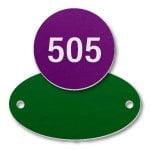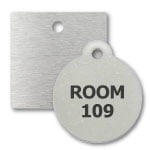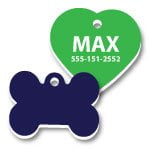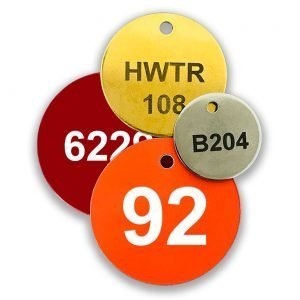Knowing the facts and options before deciding which material is the best choice for your tags, will help you avoid wasting time and money.
Your choices are not so crucial if your needs are for light-duty or office environments. But, industrial work places will need a bit more thought with regard to your durability needs.
Industrial environments are tough on equipment, parts, and systems. They often include exposure to, not just normal wear and tear, but harsh chemicals, high heat, and extreme cold. Making sure your parts, equipment, and systems stay marked adequately during their lifespan is essential. Employing the most durable material for your tags ensures those items stay sufficiently marked for many years to come. And, you save time and money by avoiding tag replacement.
Metal tags, in general, can withstand the harshest environments. They’re used in most industrial work situations, on construction sites, in workshops, and in similar places.
In comparison, plastic tags are perfect for many common conditions like retail stores, offices, and indoor spaces where harsh use is not likely. They’re ideal for situations where extreme heat or cold isn’t an issue. They’re also electrically non-conductive. So, electrical applications often require plastic tags.
Brass tags, specifically, might be required in some industrial applications. But, when a decorative, attractive tag is desired, they’re notably popular.
Let’s look at each tag material in more detail to help you decide which material is the best choice for your tags.
Anodized Aluminum Tags
 Inland Products commonly offers anodized aluminum tags in 0.020 inch and 0.050 inch thickness and in many color options.
Inland Products commonly offers anodized aluminum tags in 0.020 inch and 0.050 inch thickness and in many color options.
Marking of anodized aluminum tags and plates can be done by laser engraving, rotary engraving, stamping, or embossing. At Inland Products, we primarily laser engrave or employ our Digital Print process for our customers. When laser engraved, the color of the engraving is white in contrast to the tag’s surface color. Keep in mind the engraving will show up better on the darker colored tags.
Anodized aluminum is lightweight but durable, is corrosion-resistant, and is a very economical metal choice. The anodization process adds extra durability while allowing for the addition of color. And, in most cases, you’re likely to have these tags last 20-plus years.
These characteristics make anodized aluminum tags an excellent choice for many uses in many industries. They can handle almost any situation and environment and are functionally appealing. The ability to add color in the anodizing process is a large part of this appeal. Your need might be to color-code certain items for safety or sorting. Or, you may simply need to employ your company colors. This option of color makes anodized aluminum tags a popular choice.
Brass Tags
Inland Products commonly offers brass tags in 0.040” and 0.020” thickness. It’s available in either industrial tumbled finish or glossy, decorative, satin lacquer finish.
 Brass tags and plates are often very popular due to their antique/vintage appearance. They have an aesthetically pleasing, high-quality look, making them ideal for decorative applications.
Brass tags and plates are often very popular due to their antique/vintage appearance. They have an aesthetically pleasing, high-quality look, making them ideal for decorative applications.
However, some industries may require brass for safety reasons. Brass is a non-ferrous metal. It’s also low-friction and less likely to generate a spark. It has antimicrobial properties and is highly durable and corrosion-resistant. You’ll often see brass used in plumbing, mining, and marine applications. But, it’s quite suitable for many more situations.
Brass tags themselves, as you can imagine, will last quite a long time. It’s the choice of marking, and where the tag will be used, that determines how long good readability lasts.
Brass can be rotary engraved, laser engraved, or stamped. When laser engraving is applied, brass tags require a fiber laser be used. A CO2 laser won’t work. Laser engraving creates a dark greyish brown, permanent design on brass. The design will sustain better readability over a longer period of time within indoor environments, especially when using satin lacquered brass. Keep in mind exposure of outdoor environments will tarnish brass, making the laser-engraved-mark somewhat less readable.
When rotary engraved, the engraving is easy to read and long-lasting due to the depth of the marking. The same is true when stamping is employed. Rotary engraving and stamping are likely to last as long as the brass tag does in both indoor and outdoor applications.
Stainless Steel Tags
 Inland Products commonly offers stainless steel tags in 0.030” or 0.050” thickness. Type 430 or 304 stainless steel is available. We commonly use 430-grade stainless steel in our stock tags.
Inland Products commonly offers stainless steel tags in 0.030” or 0.050” thickness. Type 430 or 304 stainless steel is available. We commonly use 430-grade stainless steel in our stock tags.
Marking of stainless steel tags and plates can be done by laser engraving, rotary engraving, or stamping. Laser engraving leaves a dark greyish brown mark. The mark is highly visible against the silver stainless steel background, and is durable and permanent. Like brass, laser engraving of stainless steel is done using a fiber laser.
Stainless steel itself is extremely durable. It’s twice as hard as brass and three to four times as hard as aluminum. And, it’s much more resistant to abrasion and damage from rough handling or extreme weather conditions. It’s highly corrosion-resistant in most applications, making it useful where strong acids or alkaline materials are a factor. Stainless steel is also capable of handling extreme temperatures up to 2500 degrees Fahrenheit.
Stainless steel is corrosion resistant enough and strong enough to withstand almost any condition. Each stainless steel grade will be better suited to a particular application. But, the outstanding durability of stainless steel makes it an excellent option for industrial applications overall.
Plastic Tags
Inland Products commonly offers ABS, UV stable, outdoor-rated plastic tags in 0.0625” and 0.125” thickness, and in several layered color options. We can make Phenolic, Acrylic, Polycarbonate, and other plastics available as well.
 Marking of plastic tags and plates can be done by laser engraving, rotary engraving, or by use of our Dura-Print process. Laser engraving removes the first color layer of our tags so the contrasting color beneath results in excellent readability of the text or design.
Marking of plastic tags and plates can be done by laser engraving, rotary engraving, or by use of our Dura-Print process. Laser engraving removes the first color layer of our tags so the contrasting color beneath results in excellent readability of the text or design.
ABS plastic tags are strong, impact-resistant, long-lasting, and economical. ABS plastic properties, like resistance to chemicals, heat, and physical impacts, make it a great material for many applications. It has excellent resistance to diluted acids and alkalis, but poor resistance to alcohols and hydrocarbons.
ABS plastic tags are typically perfect for non-harsh, indoor applications, where weathering, abrasion, and the like aren’t likely to be a factor. This makes them a great choice for use in retail stores and offices. They’re commonly used as name tags, key tags, and they’re great for business and brand promotional items too.
Plastic tags are electrically non-conductive. So, they make ideal warning labels in high-voltage and similar environments where safety labeling is required.
Still not sure which material is right choice for your tags? Give us a call! Phone 1-800-481-5500. We’re more than happy to assist you!


